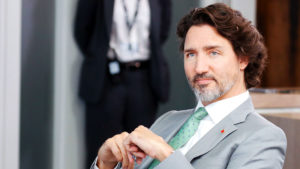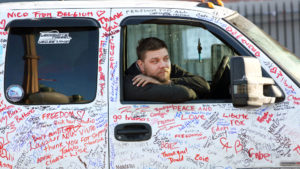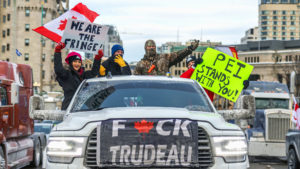Canadians aren’t known for the depth of their political feeling. If anything, our easy-going passivity is often a point of pride and distinction against our overzealous neighbours to the south. Yet if the recent Freedom Convoy revealed anything, it was that deep rifts do exist in Canada — and they could soon boil over.
In many ways, these divisions are unique: they are not draped in the usual identitarian focus on race, gender and sexuality that has come to define the West. Rather, they are between those minority groups which embrace a sense of victimhood and those which reject it; between the strong, self-determining subject capable of rational judgement and between the vulnerable subject who demands protection. Nowhere is this clearer than in the contentious case of indigenous participation in the Freedom Convoy.
Even in my own family, the truckers’ protest sparked an unprecedented sense of discord and division, both on and off reserve. In recent weeks, I have spoken with several relatives and their contacts who participated in and organised portions of the Convoy. What emerged was a sense of division that is a microcosm for a more fundamental rupture in mainstream Canada and beyond.
This is to be expected: no matter how hard policymakers and even indigenous leaders try to convince us otherwise, the issues faced by indigenous people are not so different from those faced by people around the world. Like so many groups, they are torn between the demand for freedom and the demand for safety. It is a conflict faced by governments and populations that predates Covid-19 — but which has become manifest with lockdown measures and the resistance to them.
While Trudeau dismissed the protests as sexist, racist outpourings of white supremacy, the indigenous participants I spoke to were keen to emphasise their diversity. Some indigenous people arrived in full regalia; a mother marched with a papoose on her back and two small children in traditional dress. “We met so many people from every background,” said an Ojibwa woman from a Northern Ontario reserve who helped organise protestors in her area. “Because we’re just like everyone else. We want the mandates to end. We want freedom of choice and autonomy over our own bodies. We want a good life and we want our children to have a good life. We want the same things.”
She pointed to problems on reserves but linked these to broader issues in Canadian society. “Like the rest of the population, we have suffered from so many drug-related deaths and suicides. Covid just made that worse. We don’t want that anymore. We’re so sad seeing this and we’re just hoping for change. Just like everyone else.”
Yet many in the indigenous community disagreed. Leaders issued statements condemning the protests, and in particular the use of traditional ceremonies and objects by both indigenous and non-indigenous people without “permission from us in order to proceed”, dismissing them as “ignorant acts of cultural appropriation”. While there was some controversy about a kitsch “pipe ceremony” that was posted online, the broader message underscored that ceremonies and ceremonial objects only have a place in certain approved protests and in relation to certain approved issues. Indigeneity, it appears, is the sole province of those who toe a certain line. And that line is not about freedom, but safety and protection.
Indeed, all these pronouncements highlighted was the insularity of Canada’s indigenous movements. Grand Council Chief Reginald Niganobe said: “Once again, we ask that you please remain vigilant within your communities where you are continued to be needed.” In a statement shared on social media, he argued: “It is counter-intuitive to the progression of our communities to be caught up in anti-government sentiment which fails to address the complexities of Anishinabe realities.”
Others framed the protests as a clear indication of racist inequality in Canada, pointing out that an indigenous-led convoy would have been met with swift suppression. The author of one such piece reflected that while some indigenous people might be attracted to the movement’s anti-establishment rebelliousness, “this is not the cause that we need to get behind because they’re not here to help our issues”.
But as Kenan Malik recently observed, racial specialness has often been used as a means of dismantling cross-race “fusion” movements that threatened the existing order. Take the struggle that brought together poor black workers and poor white farmers in the American south during the early 20th century. Rather than organising together, white workers were persuaded that their interests lay not in their class position but rather in their racial uniqueness. Of course, certain groups undoubtedly suffer individualised issues. Historically, however, the distinctiveness of one’s struggle was preached precisely to destroy the power of solidarity movements to achieve change.
And this is a danger that still runs deep today. Indigenous people are constantly invited to believe that their problems are distinct and rooted squarely in the past. When news broke last summer about the alleged existence of unmarked children’s graves at a Kamloops residential school, the media was awash with tales of suffering and horror. While many indigenous people did suffer greatly in these schools, it is important to note that not all children attended them. Nonetheless, a predictable narrative began to emerge: that, however indirectly, all indigenous people are essentially traumatised by this past. As one academic put it at the time, indigenous people have “ongoing issues in our communities that are a direct result of these schools”, and the failure to recognise this ensures “that new generations are continuing to suffer”.
Such claims about the colonial trauma experienced by all indigenous people have not been dampened by more recent evidence that the evidence of mass graves is shaky. It fits too well with the dominant ideal of the indigenous victim. As one young woman put it: “We’re still experiencing the effects of the residential school from our parents and grandparents. We’re all damaged, and we’ll pass it on to our children, so it will never end.”
With victimhood now all but regarded as an innate indigenous characteristic, it is hardly surprising that indigenous frauds have started to fabricate entire identities grounded in this trauma: Saskatchewan professor and public health expert Carrie Bourassa was revealed last year to have fabricated claims to indigenous heritage, appearing publicly in elaborate dress as ‘Morning Star Bear’ with attendant melodramatic theatrics. While organisers of the Freedom Convoy have similarly been outed for making shaky assertions about their mixed roots, it is interesting how long Bourassa’s claims went undetected.
Bourassa climbed the career ladder for years, steadily growing bolder with expanded claims to indigenous heritage and cultural roots. Why? Because Bourassa told a story that people wanted to hear. She talked of suffering, addiction and “endemic” sexual abuse — experiences that were likely a far cry from her comfortable middle class upbringing in Regina. “Everybody around me was either an alcoholic, drug addict or suffered from some sort of addiction,” she embellished. “There was a lot of violence in my family.”
True or not, here we had a story of a virtuous indigenous victim — the sort of victim that inspires a carefully positioned Justin Trudeau to be photographed with a single tear running down his cheek; the sort of victim that legitimises his decision to exclude indigenous citizens from obeying his draconian emergency laws without needing to explain why.
And for the people I spoke to, this can have an unintended effect: it makes them feel like frauds because that narrative of trauma is not their experience. Even if it were, I am not convinced it would be capable of fulfilling their desires for more control and freedom to decide how to live their lives.
Quite the opposite. As indigenous scholar Dian Million has warned, this narrative of virtuous victimhood runs expressly against claims to self-determination, a long established goal of indigenous communities. This is because when we assume victimhood, we often relinquish power. Constantly invited to confess endless tales of suffering and damage, the call for “self-determination” fades into “self-management” and the therapeutic “empowerment” of outside agencies.
And this is echoed throughout Canada at large. In recent years, indigenous communities have started to groan under the weight of expanding bodies of surveillance. It’s striking, then, that during the recent protest, truckers spoke of the encroachment of endless managers into their work, subjecting them to increasing surveillance, such as fitting their trucks with cameras in their cabs. And like indigenous leaders’ disavowal of indigenous participants’ demands for freedom in favour of safety, so too did the truckers’ unions retreat into threats, seeing their main role as providing not self-determination but safety.
Indigenous experiences, then, are a microcosm of Canada. We are not so different. Like so many others, some of us reject the vision of virtuous victimhood. And it is testament to the power of this unity that our community leaders should respond with such horror. They’ve finally sussed out that we too are the “Average Joe” — and as one indigenous participant told me: “The average Joe has had enough.”
Disclaimer
Some of the posts we share are controversial and we do not necessarily agree with them in the whole extend. Sometimes we agree with the content or part of it but we do not agree with the narration or language. Nevertheless we find them somehow interesting, valuable and/or informative or we share them, because we strongly believe in freedom of speech, free press and journalism. We strongly encourage you to have a critical approach to all the content, do your own research and analysis to build your own opinion.
We would be glad to have your feedback.
Source: UnHerd Read the original article here: https://unherd.com




